
It’s been a bit over two months since Fitbit announced their latest wearables, the Fitbit Charge 2 and the Fitbit Flex 2 (they also announced some Blaze updates and Alta bands at that time). This review however is purely focused on the Fitbit Charge 2, which is the successor for the original Fitbit Charge HR. The name got a switcheroo, since the Fitbit Charge 2 now incorporates optical HR, whereas the original Fitbit Charge did not (but the Charge HR did). Got all that? Good.
I’ve been wearing the Fitbit Charge 2 for a bit over a month now, comparing it day by day to other watches and wearables. Within this review I’ll dive into everything you’d ever want to know about it, from the device usability, to the accuracy, to that of the platform and mobile app. I’ve got it all!
Fitbit sent me a trial unit of both the Charge 2 and the Flex 2, which as usual I’ll return to them upon completion of this review. I’ll then go out and get my own through regular retail channels like normal. If you found the review useful, you can hit up the support links at the end of the post.
With that – let’s begin!
Unboxing:

The Fitbit Charge 2 comes in a relatively small box, with relatively few components inside of it. I’m all about minimalist unboxings.
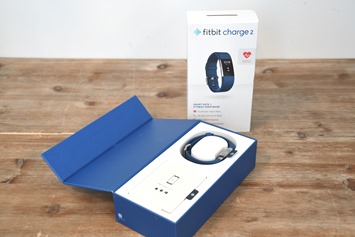
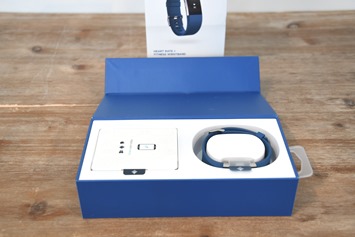
Here we’ve got on the left the USB charger, two pieces of paper, and on the right the Fitbit Charge 2 itself. Like I said – simple.
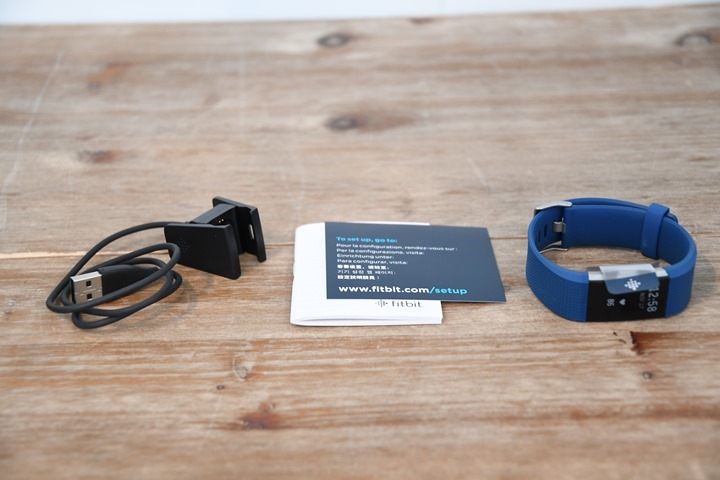
The quick start guide paper tells you to head to Fitbit’s site to get setup, while the thicker white manual gives you a bunch of boring safety and warranty information. Essentially, if you develop a rash and your wrist falls off – it’s your fault.
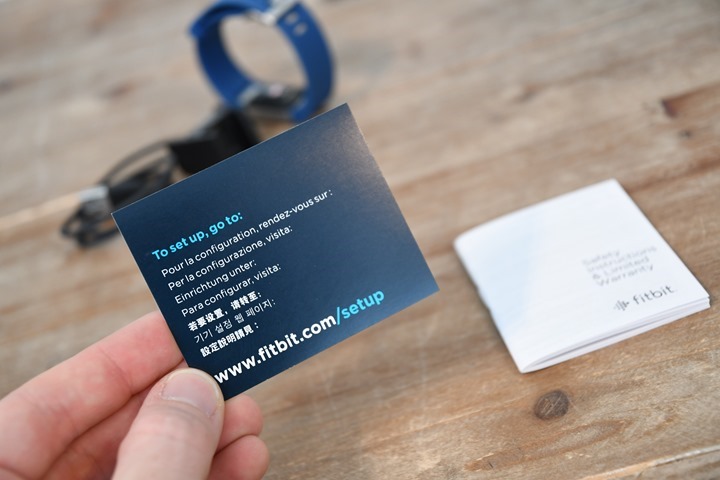
Meanwhile, here’s the unit itself:
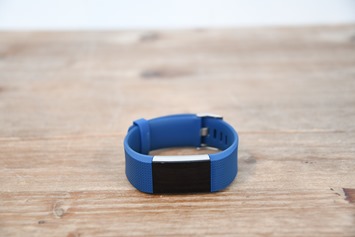
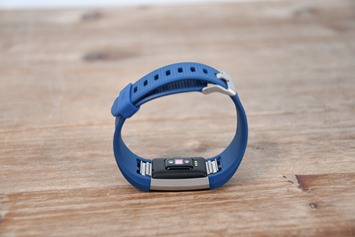
The charging clip simply snaps onto the bottom of it. It’s pretty secure, so there’s no issue with it falling off like some of the older Fitbit wearables charging clips.
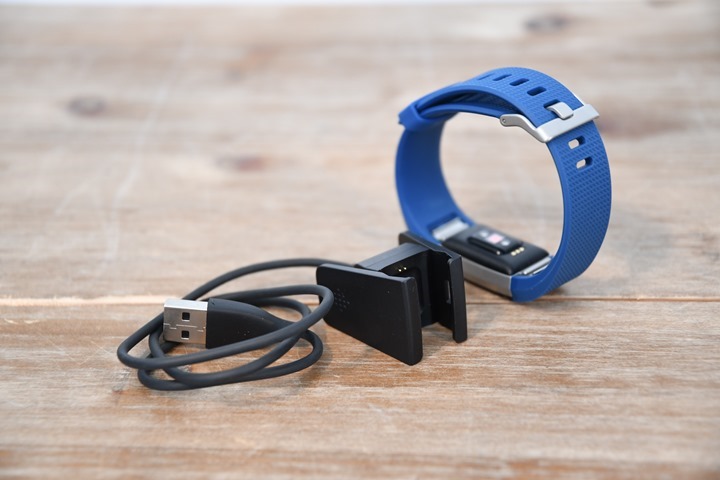

Note that the band on the Fitbit Charge 2 is swappable. You can see how you press these little snaps on either end of the pod, and it’ll pop out of the strap.
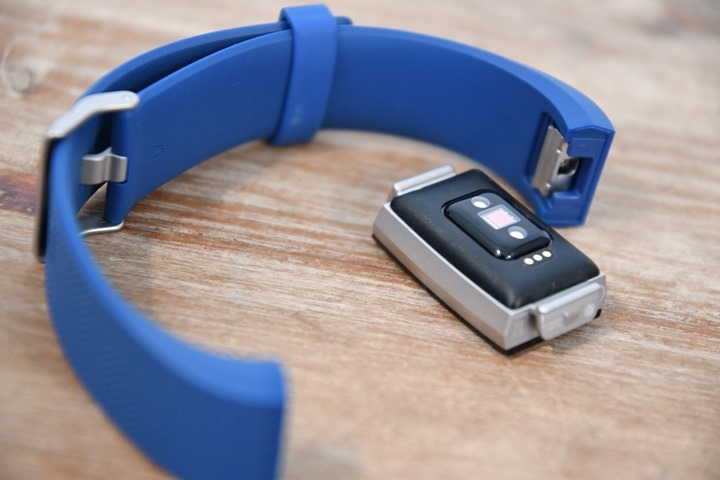
Fitbit then makes other colored straps, like these bits of Skittles awesomeness:
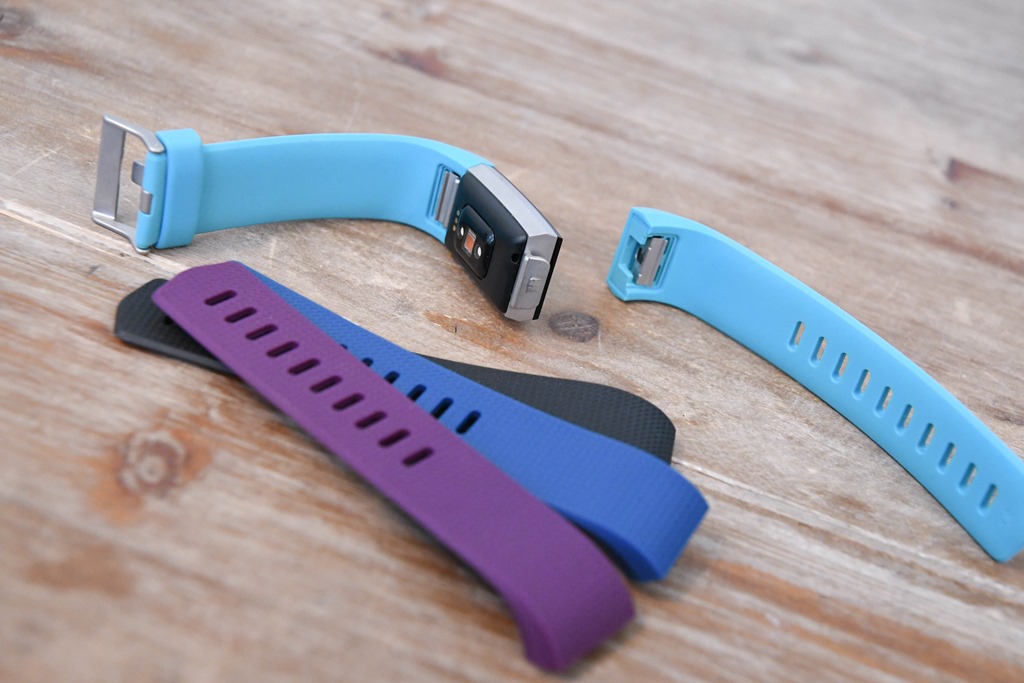
Finally, if you check out the weight of the unit, it comes in at 35g:

Meanwhile, here’s a few comparisons. We’ve got the Garmin Vivosmart HR (sans-GPS), which is at 30g, and the Polar A360 (sans-GPS) at 37g.


Ok, with that, let’s start using it.
The Basics:
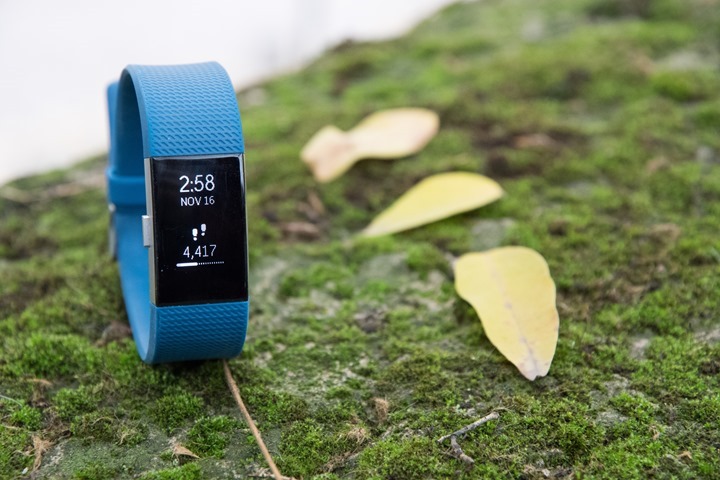
The Charge 2 is in most ways like existing Fitbit wearables, except with slightly more options and features. To begin after setup, you’ll iterate through the menus by either tapping the screen or pressing the side button. However, the unit also supports raising your wrist to see the stats:
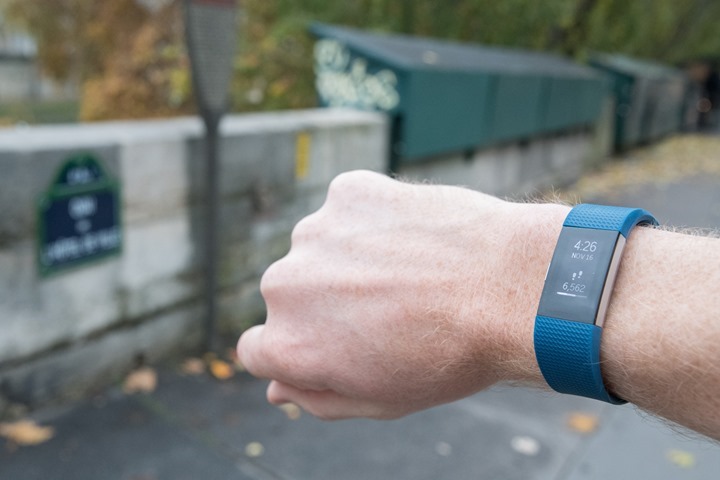
When you do so it’ll show you the last stat you’ve configured. In my case that’s the time, date and steps. However, you can then tap the display to change it to any other given metric. These metrics include: Current HR, Distance, Calories, Flights of Stairs, Active Time, Steps toward hourly goal, Daily Total Steps. Here’s some of those:
Meanwhile, you can then press the side button to change into different modes. These modes include just showing your HR, sport modes, stopwatch, and breathing sessions. For example, once you’ve selected the sport modes, you can then iterate through the different sport modes by tapping. This would then (by default) show Running, Weights, Treadmill, Bike, Workout, Elliptical, and Interval Workout.
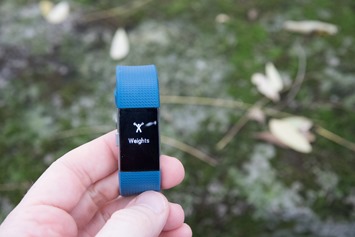
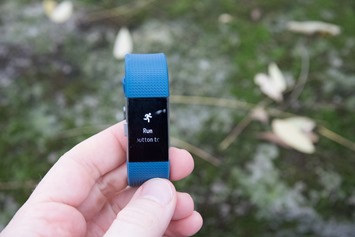
I’ll cover other workout modes in the next section – so hang tight a moment.
So how does accuracy rank? I’ve been wearing the Fitbit Charge 2 and Garmin Forerunner 35, one on each wrist, 24×7 for the last month. Here’s a random 5+ days worth of data (in between charges) from steps and how they shake up:
Nov 16th:
Fitbit Charge 2: 11,271
Garmin FR35: 8,403
iPhone: 9,521
Nov 15th:
Fitbit Charge 2: 7,699
Garmin FR35: 6,593
iPhone: 4,170
Nov 14th:
Fitbit Charge 2: 8,031
Garmin FR35: 6,327
iPhone: 3,377
Nov 13th:
Fitbit Charge 2: 11,849
Garmin FR35: 10,719
iPhone: 6,719
Nov 12th:
Fitbit Charge 2: 6,688
Garmin FR35: 3,464
iPhone: 4,355
Nov 11th:
Fitbit Charge 2: 12,260
Garmin FR35: 8,365
iPhone: 8,331
I don’t have a very clear idea of which one is right of course, since there’s no easy way to track that across an entire day. Additionally, the different placement aspects would impact things (left wrist vs right wrist vs phone in pocket). I saw nuances in how sometimes one device would pickup more artificial steps than another (such as when swaying a baby to sleep), yet at other times another would be more tripped up by a bike ride.
As I’ve noted many times before, it’s generally better to treat these values as a yardstick and for trending. Don’t fret if you’re trying to hit 10,000 steps and you get only to 9,900. Just go walk the other 100 steps. It won’t kill you. Meanwhile, on the day you walked only 2,000 steps – yes, you were likely lazy. That’s OK – just accept it. Most of the times (like you see above), they tend to trend the same. So largely speaking the Fitbit Charge 2 tended to trend highest of the three.
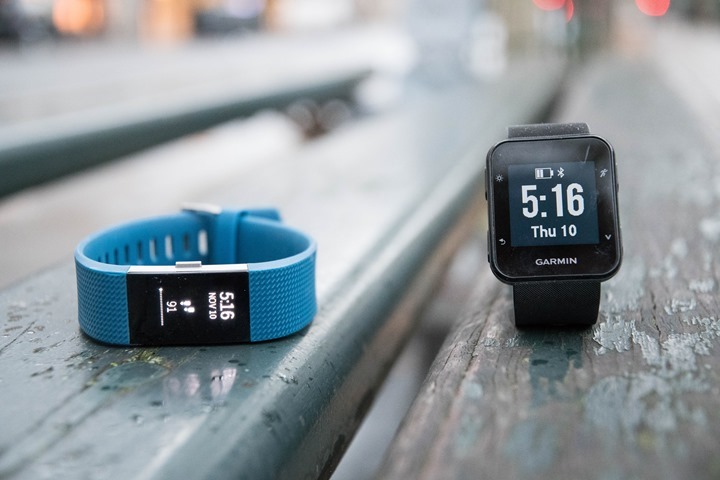
As you might have noticed, I actually get slightly better battery life than they claim – just shy of 8 complete days between charges. Not too shabby since they only claim 5 days.
Next is that throughout the day you’ll be reminded to keep on walking. Fitbit sets a non-configurable goal of 250 steps per hour. While visiting family a few weeks ago, my cousin asked why Fitbit doesn’t allow you to change that warning level, since in reality – 250 steps per hour will still leave you far short of your normal/default 10,000 step goal. It’s a valid question, since you can change the default daily total, just not the hourly chime.
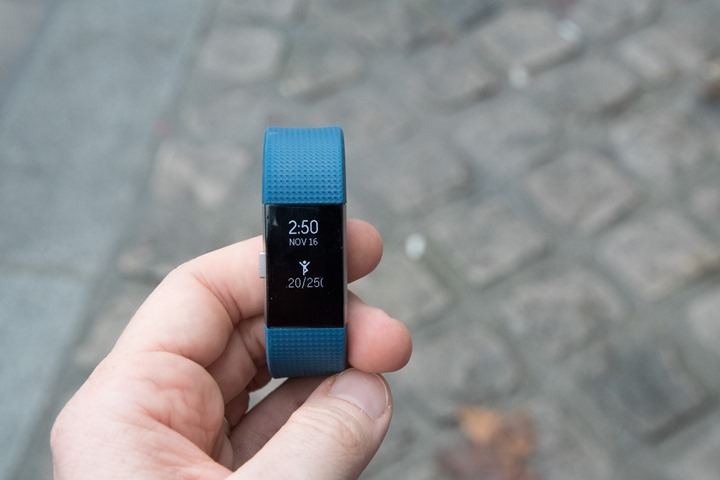
That hourly chime by the way, will remind you at 10 minutes to the hour. So each hour at 5:50PM, 3:50PM, etc… You can specify the range of hours that it buzzes at you, so it won’t be poking you at 3:50AM.
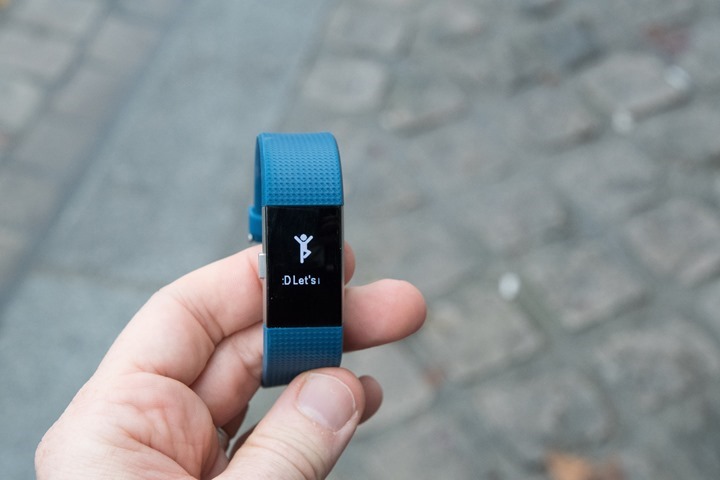
Speaking of buzzes, the unit will display some smartphone notifications. Specifically, it’ll display text messages, call notifications, and calendar alerts. It shows up like this:
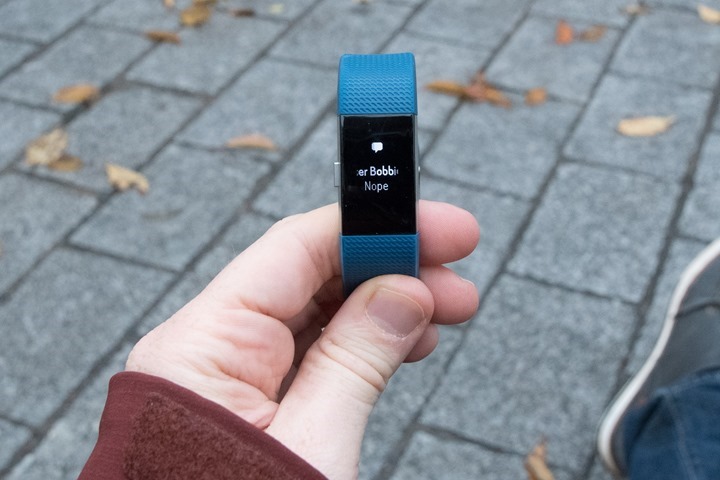
It’s long been a bone of contention that Fitbit still doesn’t display regular smartphone notifications from other apps, such as WhatsApp, Twitter, and Snapchat. Only the Fitbit Blaze gets those. Whereas virtually every other activity tracker on the market receives anything you’ve configured on your phone. In a world where more and more people are depending on 3rd party apps like Facebook Messenger and others for communication, it’s backasswards that Fitbit still tries to hold the line to legacy call and text only. And yes, I’m going to keep banging this drum until they change it (it’s the same drum that every other major review has banged as well).
You can configure notification options through the app:
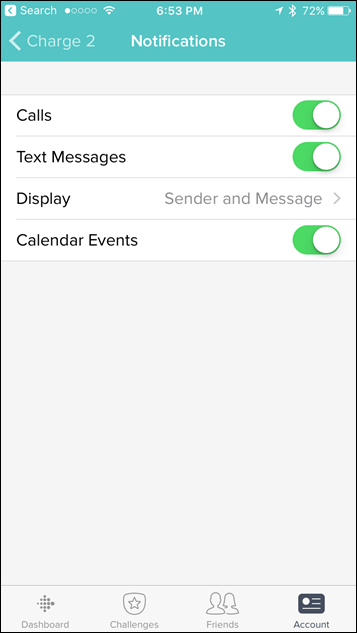
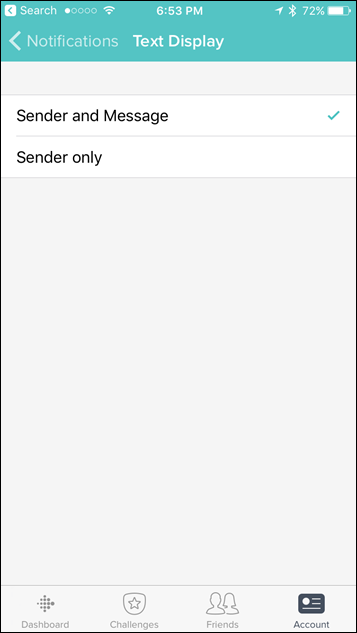
Along the alertation front, you’ve also got the ability to create silent alarms, which can be helpful if you’re sharing the bed with someone else not waking up at the same time.
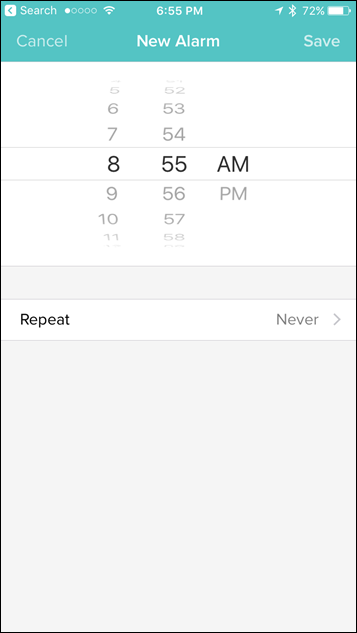
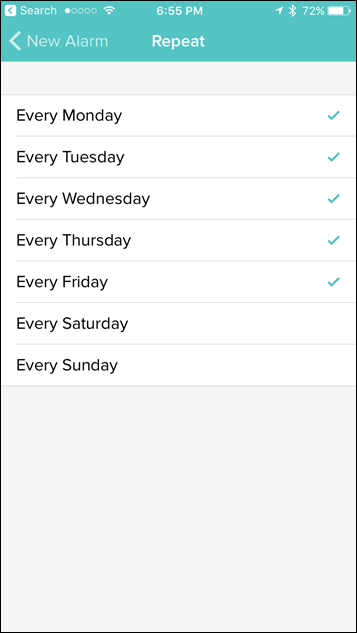
Now’s a good time to point out that the unit can’t make any beeps. Only vibrations. To be fair, that’s somewhat common on wearables, where space/cost/battery life is saved by skipping that.
In my case, I used Fitbit’s ‘All Day Sync’ option, which keeps the wearable constantly sync’d to the mobile app (steps/distance/activities/etc…). In fact, you can even display your current HR on the mobile app – a feature that virtually no other wearable supports. You’ll see that on the below screen, directly under the heart icon.
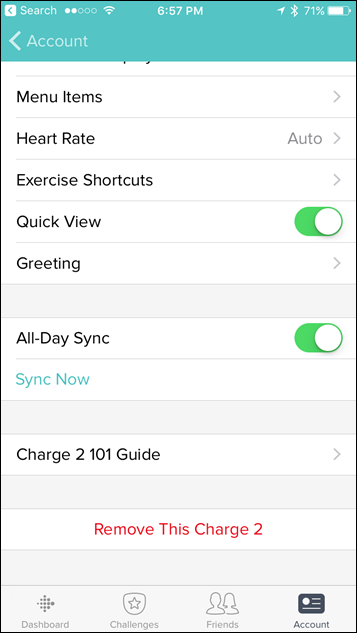
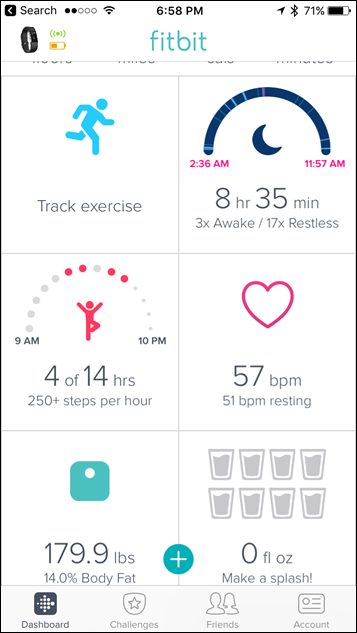
Finally, let’s talk about the breathing exercises, which is designed to promote relaxation. It’ll walk you through a few minute breathing exercise. It’ll guide you to take deep breaths in and out slowly, which it’ll then plot on a little wavelength chart.
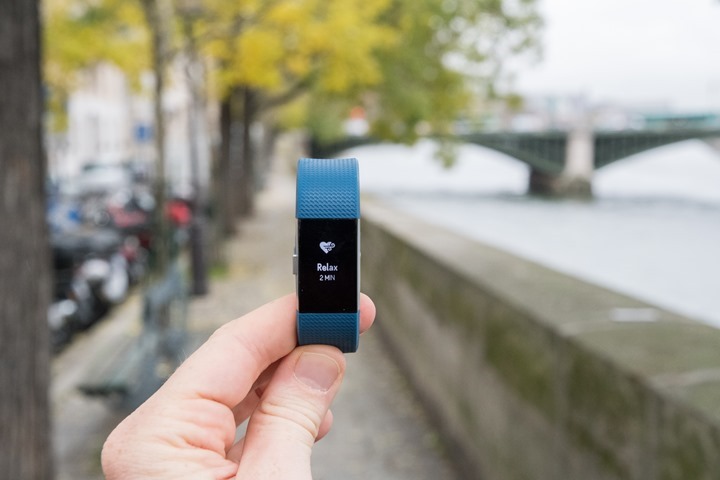
While this did relax me slightly, I wouldn’t necessarily say that the recorded/displayed data matched that of my breathing rate. I could take deep breaths and it’d largely flat-line, while shallow breaths did the opposite. And then sometimes that was swapped.
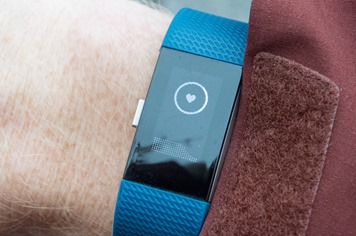
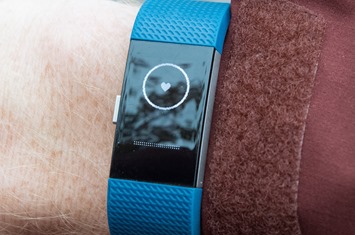
With some relaxation out of the way, it’s off to workout we go. No better way to get the heart rate up. Well, actually, I can think of better ways. But the Fitbit doesn’t seem to have a workout category for that.
Workout Modes:
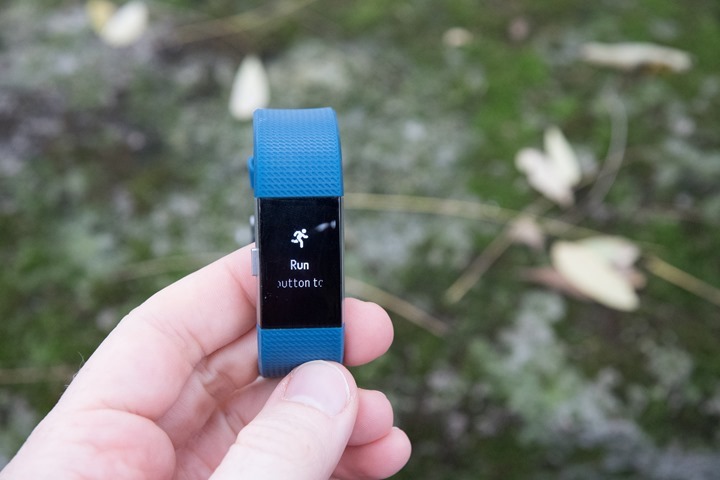
One of the key changes to the Charge 2 is the ability to have unique workout modes. Previously in the original Charge HR you just had ‘a workout mode’, but not ‘modes’. Meaning, it was all or nothing. Now, you’ve got specific modes for different types of workouts. If you run, it’ll categorize it as running. Same goes for cycling, and so-on. Further, by doing this it can leverage Connected GPS capabilities (aka your phone) to provide GPS tracks for outdoor workouts.
To start a workout, you’ll press the side button until you see the workout modes listed. By default the first one is running. But you can change both the order and listing of workout types.
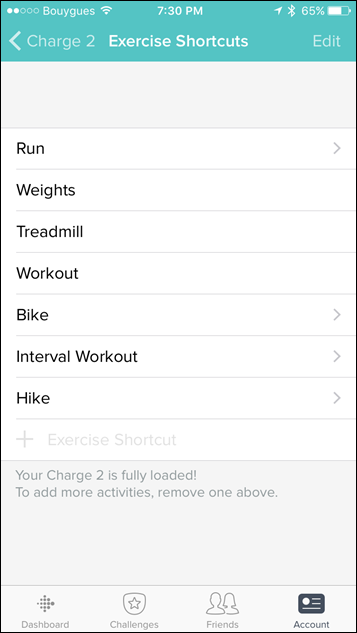
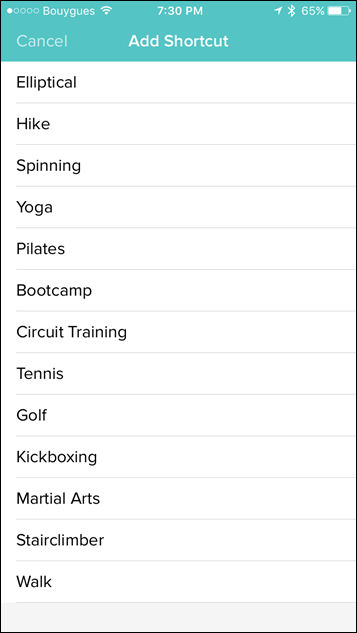
The unit supports the following workout types: Run, Weights, Treadmill, Workout, Bike, Interval Workout, Elliptical, Hike, Spinning, Yoga, Pilates, Bootcamp, Circuit Training, Tennis, Golf, Kickboxing, Martial Arts, Stairclimber, and Walk.
All of these can be configured within the app. And as mentioned earlier some workout types (like ‘Run’) support the ability to use what Fitbit calls ‘Connected GPS’, which means it’ll use your phone for GPS. That’s because the Charge 2 doesn’t have a GPS chipset within it. So it’ll connect to the Fitbit app (which has to be open) on your phone and then record distance and a map using that.
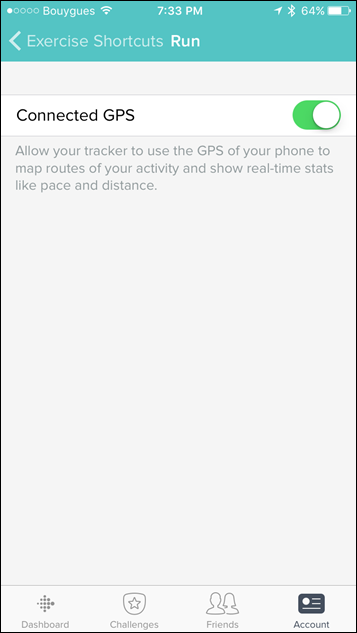
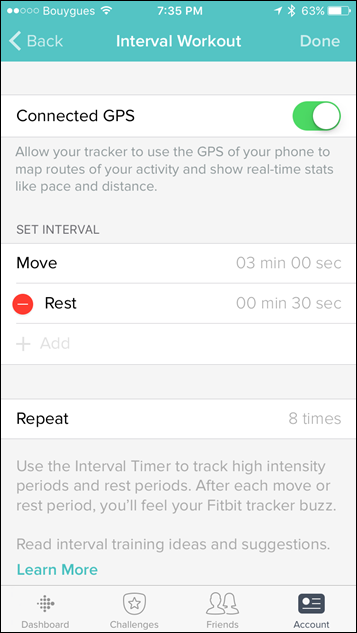
While other workout modes, such as the Interval Workout option, allow you to setup intervals as seen above. This will iterate through each of the intervals, giving you short guidance on the unit itself and counting down time remaining for each portion and the total workout.
However, it’s super-limited. For example, you can’t specify a warm-up or cool-down. And even though you’d think from the above screenshots that you’d be able to create additional entries in that list, you’re limited to a whopping two entries, just the ones seen. In fact, I’m really not sure why they even have the ‘Add’ button, since you can only have one move, and one rest. Shrug.
In any event, once you’ve selected the workout type on the wrist, you can hold down the left button to start the recording/timer. The one downside here is that you won’t really know if it’s successfully connected to your phone for ‘Connected GPS’ until after you’ve held down this button. It’s at that point that it either gives you a happy dance, or a SOL dance. If it gives you the SOL dance, then you’ve gotta kill the workout, troubleshoot the phone connection, and do over.
Once in workout mode, you can tap the screen to change the various metrics displayed.
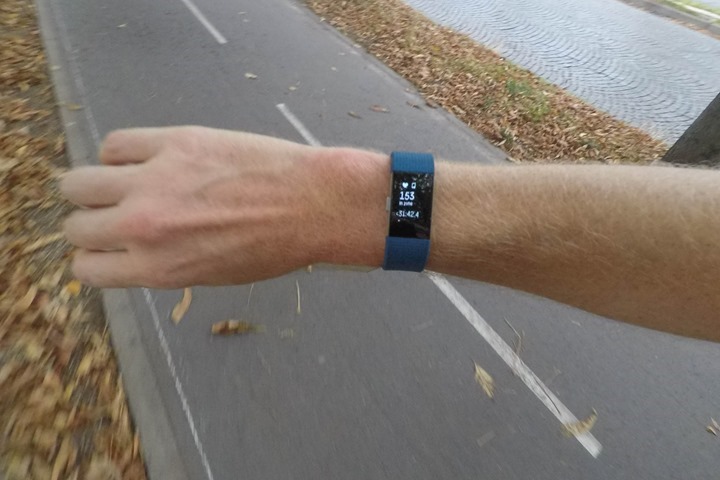
It’s all pretty straightforward, as well as non-changeable. I’ll discuss the heart rate accuracy piece in the next section. Note that if you’re using Connected GPS for outside GPS tracking, then you’ll get a nifty map of where you’ve been afterwards:

Well, most of the time anyway. I’ve had a few cases where it just simply craps out mid-way through the bike or run, for no apparent reason – like below. This is actually a 48.79mi ride (not 15.62mi) that started/ended in roughly the same spot. GPS stopped mid-way, yet it continued to track time. Though, it totally hosed up the HR and related metrics, which are truncated to the abbreviated distance.
(Note: Fitbit is looking into what might be occurring on this and other activities I saw similar or troublesome ‘Connected GPS’ behavior. I’ll circle back once I hear back with the results of their investigation.)
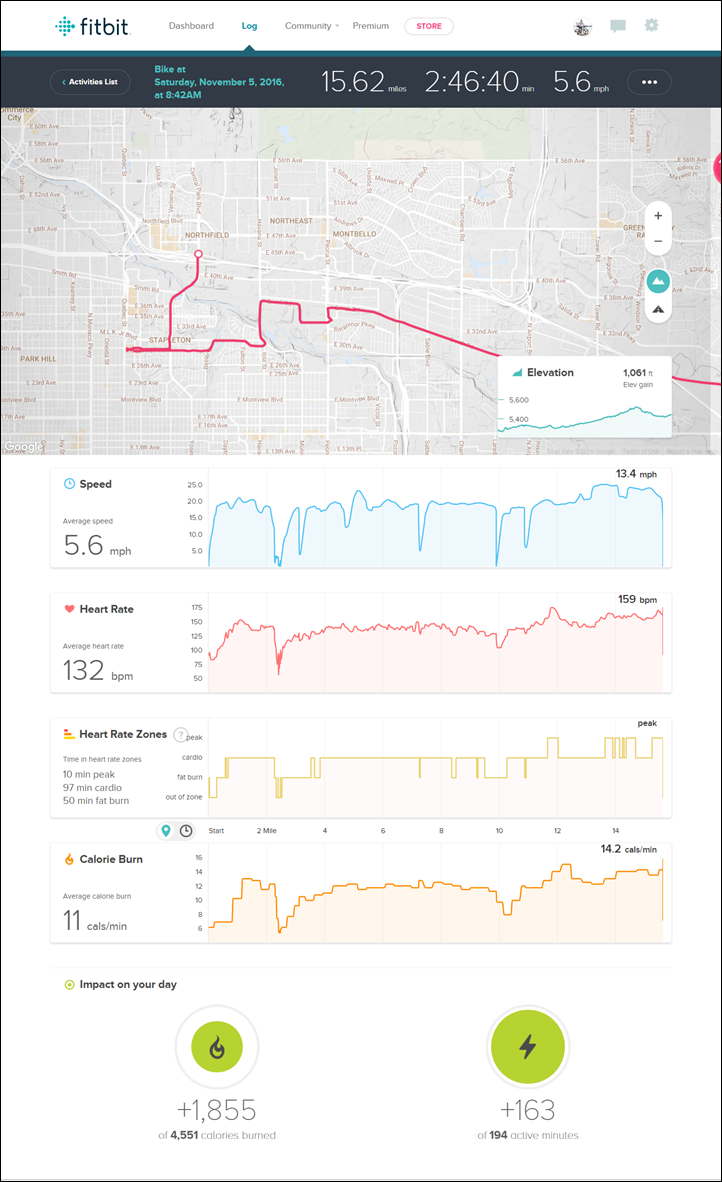
Once your workout is complete you can look at the stats on the Charge 2 itself, or afterwards on the app and/or site. Here’s how it’d look on their site:

Note that if you have your account setup to sync to Strava, it’ll send that workout file over to them automagically, such as below:

That setting can be found in in the Applications area of the settings control panel:

Lastly, you can also download workout files through their website, for manual transfer/uploading to other 3rd party sites. These files are broadly compatible, as they use the TCX file standard.

Overall the new workout modes work well. It’s a nice improvement that helps differentiate it from other wearables that may just have a generic mode, including the older version of the Charge. Also note that this is separate from the automatic exercise recognition, which won’t show up on the wrist band itself, but rather only afterwards on the app (I’ll cover that in the app section).
Finally – one last important thing to mention somewhere besides the data charts is that the Fitbit Charge 2 is somehow still not officially waterproof. Rather, it’s splash and rain proof – but the company says it shouldn’t be showered or swam with. Still, I ignored that. I showered with it every day, without issue. Just like I showered with the Charge and Charge HR every day and it came out fine. I also went swimming with the little baby at the pool, but that’s more like casual splashing.

But I wouldn’t do any extended lap swimming with it – as I suspect it’d kill it. Still, it boggles my mind that somehow Fitbit continues to make non-waterproof activity trackers. This isn’t rocket science, and every other competitor makes them waterproof – often to 50m of depth (more than enough for an activity tracker). Sigh.
But for now, let’s talk about how accurate the optical HR is.
Heart Rate Accuracy:
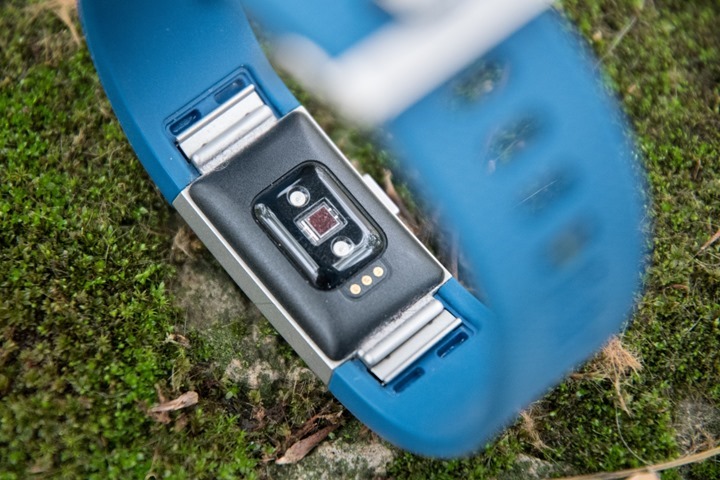
Anytime you add an optical heart rate (HR) sensor, you’re going to need to look at whether that optical HR sensor is accurate. In general, accuracy differs between the two most common uses of optical sensors: Workouts (exercise), and the remaining portion of your day – continual HR monitoring. For most devices, the continual HR monitoring that occurs throughout the day is the easy part. That’s because it doesn’t have much ‘noise’ to deal with in terms of running cadence or flexing of wrist muscles. Both of which are challenges that optical HR sensors have to overcome. In many cases, an optical HR sensor can become confused between the force of a foot strike and your heart rate, since at typical running cadences those two numbers are very similar. A hard foot strike effectively becomes your HR.
With the Fitbit Charge 2, I first looked at sedentary/continual HR monitoring. In this area, the unit generally does well. It’s within a few beats of a heart rate strap in most sitting/walking/typing/etc situations. As I sit here right now, the Fitbit Charge 2 is at 63bpm, while on the other wrist the Garmin FR35 is at 61bpm. Close enough given recording update rates/etc… I’ve been watching these values over the course of the last four weeks, and by and large they are virtually always within a few beats of each other, baring any slight differences in update rates (how quickly one might respond to a given stimulus).
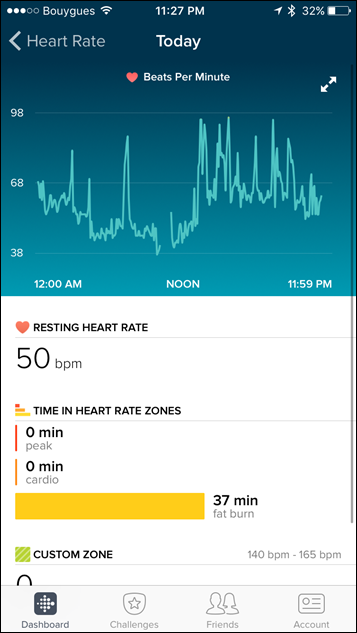
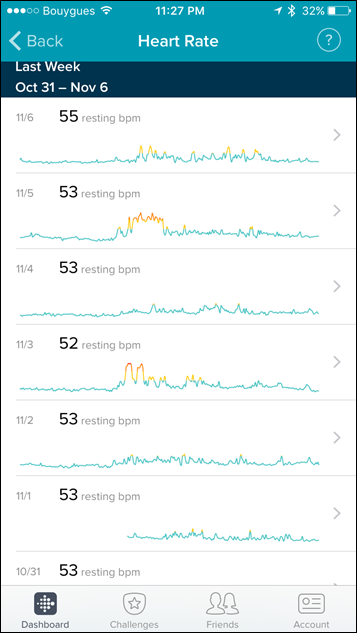
One slight annoyance of the Fitbit platform compared to others is their definition of resting HR, which isn’t the lowest HR recorded over the course of the day, but in theory the lowest HR while you’re awake. However, it seems to often misinterpret that. Meaning, I can sit still and watch TV and get a 40-41bpm resting HR within a few minutes. But it won’t show that on my trending data. Instead, it’s always in the 50’s.
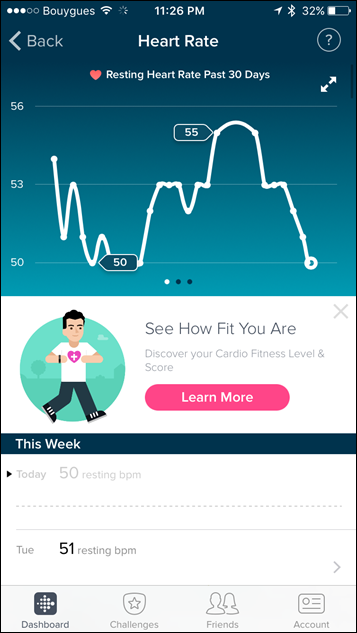
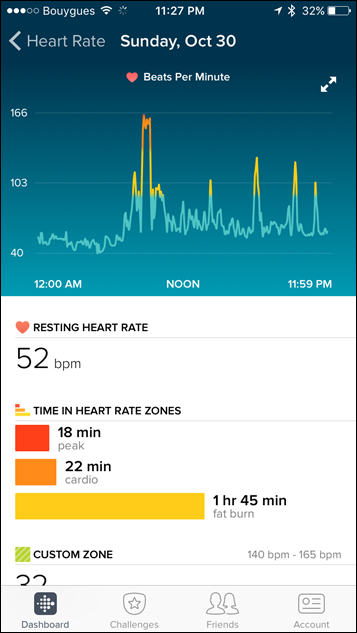
Fitbit’s own site contradicts itself here, where in one sentence it says it uses sleeping HR data, and then the very next sentence it says it doesn’t. Either way, it doesn’t much matter since it ignores the very data it records.

Next, workouts. Workouts are far tougher. For example, how quickly does the optical HR sensor respond to sharp changes in intensity (i.e. a sprint)? Or how well does it respond in cases where the wrist muscles might be taunt – such as while cycling or lifting weights. Again, areas optical HR sensors had struggles.
In my tests, I’m generally comparing against two or more additional units. Typically another optical HR sensor on a different wrist (never do tests with more than one optical HR sensor on the same wrist, as it’ll impact tests), and then a chest HR strap for comparison. Keep in mind that chest HR straps are just as susceptible to error as other device types, they are not infallible. To this day one of the most popular posts I have is around troubleshooting chest straps giving incorrect results, especially in cooler/dryer fall weather – primarily in the first ten minutes before you start sweating.
With that in mind, let’s dive into some results. I’m going to highlight a handful, but you can hit up the tables in this post to use the DCR Analyzer and dig more deeply into any of the comparative workouts. Oh, and one final caveat – unfortunately, Fitbit doesn’t correctly export HR data for activities that don’t have GPS with them. And by ‘correctly’, I mean ‘at all’. I noted this problem way back in my Fitbit Blaze In-Depth Review, but alas, nothing has been fixed. So that’s severely limited my analysis capability, since it makes it much less precise to compare HR accuracy.
On this first run, the route and intensity were both pretty flat, with only small variations.

You can see that right off the bat all three units disagreed. For whatever reason the traditional chest heart rate strap was crapping itself until I adjusted it at the 6 minute marker, then it was happy from there on out. Meanwhile the Fitbit Charge 2 spiked early on (inaccurate) while the Garmin FR35 stayed a bit more constant. In those first 5-6 minutes it’s hard to assign a specific winner, however my (pretty educated) guess knowing my HR intensities is that the FR35 was most correct. The Fitbit Charge 2 spike was incorrect, and it’s unlikely that I’d have been at that high of a HR early on. You see all the units converge as I went up a short climb.
Next, you’ll notice a short segment where I stopped briefly at a stoplight. You can see the HR recover between the different units. The Charge 2 actually does a better job of the recovery than the Garmin FR35 optical HR did, though not as correct as the quick recovery seen on the traditional chest strap.

And if I look at the last half of the run, things were very close between the three units. Which is what I tend to see on reasonably flat runs – most optical HR sensors get it right eventually.

You can dive into the above workout in more detail here.
Now as much as I’d like to dig into all my runs in more detail, as I noted earlier that’s actually really tough to do since the export on Fitbit’s site doesn’t export GPS-less HR data. For example, I can compare this HR graph during a trail run using screen clips – but it’s difficult to accurately see:


Still, in the above you can see distinct differences of opinion between the two units, somewhat common as I was starting out on a cold morning. The Garmin FR35 shows a more gradual increase in HR, while the Fitbit Charge 2 seems to flat-line out a bit early on. Both seem to roughly trace each other, but there are many nuances that aren’t clear.
Let’s instead look at a bike ride, since those Connected GPS rides do correctly export out HR data. Here’s a 90ish minute ride I did. Actually, it’s about 30 minutes of riding each way, with 30 minutes of photo/video shooting in the middle stationary. Either way, I’ll just let you ponder this graphic for a second.

So collectivity everyone sucked.
Or at least, the optical HR sensors did. This also isn’t surprising. It was a cool day riding, and since my wrists were exposed, that would have impacted the optical HR sensors in that area. Further, most optical HR sensors on the wrist have a tough time – and both the FR35 and Fitbit Charge 2 differ significantly here from the chest strap (connected to the Edge 820).
However, if I had to assign a ‘less sucky’ winner, it would be the FR35. The Fitbit Charge 2 is clearly furthest afield from the other two in most cases, especially the part where I’m standing around – which is kinda funny. But even on the first half there’s large gaps where it’s just lost. If you want to dig into these files more, you’ll find that mess here.
I wish I had a better way of analyzing more data. Other GPS based activities I did failed to record fully/properly, such as a 3hr ride, which is missing vast chunks of data. And then another run that was outdoors with GPS and thus also exportable HR also failed to set the GPS data, therefore I can’t compare HR data either. Still, the rough pattern I see is that for steady-state runs the optical HR sensor seems mostly fine. Cycling generally appears to suck. However for more varied intensity running you see slowness to respond in some areas while being a bit better than responsiveness that I saw on the first edition Fitbit Charge HR (non-2).
One last item – in theory I’m supposed to get a Cardio Fitness Score upon completing runs, which is essentially your VO2Max renamed. Fitbit says that may take some runs to appear, but in reality it still hasn’t shown up for me after any runs or rides (it sounds like it only works on runs). Perhaps my runs have been too hilly for the scoring algorithm to work.
GPS Accuracy:
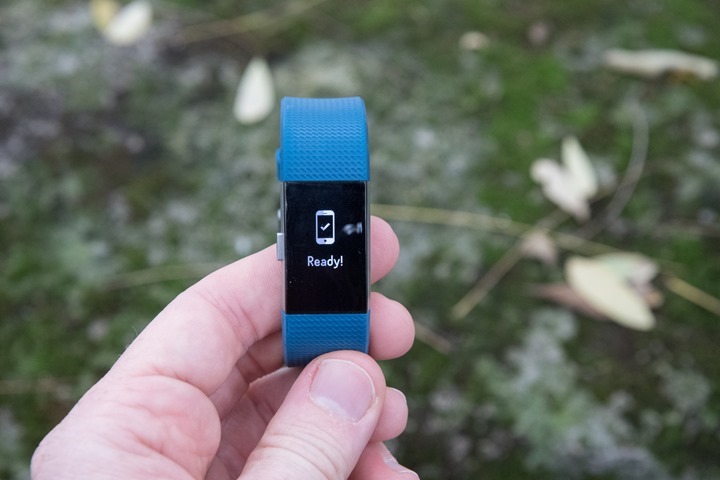
I’m only briefly going to touch on this, because in many ways it’s not real device GPS accuracy, but rather your phone’s GPS accuracy. And that will vary based on a crapton of factors, most notably your exact phone model.
With the Fitbit Charge 2, it uses what Fitbit calls ‘Connected GPS’, which means that it uses your phone’s GPS antenna. The Fitbit Charge 2 doesn’t have GPS itself. In order for Connected GPS to work, you need to be within range of your phone, and Bluetooth must be enabled on said phone. Further, the Fitbit app *must* be open and running in the background for this to work. And even with all those requirements, I find it sometimes finicky, especially if the Fitbit app hasn’t been opened extremely recently. It seemed best practice was to open the app up and then lock your phone’s screen (as you’d likely be putting it in an armband while running, or your back pocket while cycling.)
All that in mind, here’s a look at how it handled on my iPhone 6 in Connected GPS mode. Again, if you have a different phone you may get totally different results (better or worse). Here we go.
Workout #1: Bike ride
For the most part, the vast majority of GPS units succeed on bike rides. Mostly because the higher rate of speed actually makes things easier for most devices. Connected GPS on the Fitbit Charge 2 is no different. You can look at the entire activity file here. However, I’m going to pick out some ‘harder’ sections – things like bridges/overpasses/buildings/etc. Starting up, a case where one direction you go around a roundabout, while another you go under an overpass. All three units handled this perfectly.

Right around the corner from the above I make a sharp turn near some tall buildings. This is the only spot where you see a slight bit of variance on the Connected GPS of the Fitbit Charge 2, which is that purple line jutting across the road for no apparent reason. But seriously, this is no more than 10-15m in distance offset.

Throughout the rest of the route you see virtually no differences between the tracks, like below:

One thing I found interesting that I’ve never seen before is that the Fitbit app/device/etc appears to actually be smart enough to not plot points where it doesn’t have good GPS signal strength. Check out the below. The way it works is that there’s a stoplight I was at that put me below a large building/shopping below (the road passes under it). The FR35 and Edge 820 both plotted wonky-ass points in the vicinity. Whereas the Fitbit Charge 2 actually plotted no points here. It simply waited until it exited and then plotted a point.

One weird oddity though is that the Fitbit Charge 2 actually recorded two miles less than the other units. Those miles vanished somewhere.
Fitbit Charge 2: 13.55mi
Garmin FR35: 15.74mi
Garmin Edge 820: 15.38mi
Which makes no sense. It was never paused (no such function exists), and the tracks match identically. It’s like it just lost distance in space somewhere…magically. There’s widespread reports of this sort of thing happening in other reviews as well as Fitbit’s forums.
Workout #2: Running
In this case, this was a city run around Paris. The phone was on a Spibelt, which means it wouldn’t have had the best GPS signal, but that’s the reality of having a wearable with no GPS. Sometimes the phone has to go in a non-ideal place. We all know that for the most part GPS is better worn on the upper-arm, but what about on the waist?
Throughout the vast majority of the run, the GPS track is actually pretty good.

There’s a case around those fountains in the park (purple) below where it seems offset a few meters, but again, no real big deal here.

The one ‘yikes’ moment is passing through/into the Louvre, where both it and the Garmin FR35 completely crapped the bed. This was a straight shot into the building and back out the other side, but both units went completely wonky. However, in a rare display of GPS prowess, the Suunto Spartan Ultra actually correctly plotted much of this portion. Assuming you ignore that it was offset 50m into the building from the street. But what’s half a football field between friends?

Still, I wouldn’t let the above dissuade you one way or another. It’s an extremely difficult passage through what is a tunnel in one of the world’s largest buildings. GPS does wonky stuff in tunnels – and even more so in tunnels in the middle of a city. What is key here is that the units very quickly recovered upon exiting the tunnel and nearing the Pyramid at the Louvre. After which, they were fine. Oh – if you’re curious, you can dive into these GPS tracks here. You’ll note on this run the distances were 7.13mi for the Fitbit Charge 2, and 7.03mi for the FR35. Basically, within stated accuracy rates of +/- 2%.
Next, what about non-connected accuracy of distance? Well for some runs I did just that. I left my phone behind and let it determine distance based on the accelerometer. You won’t get a GPS track, but you will get distance. In many ways, that’s actually not to shabby. Just to keep things simple – here’s the distances reported by the Fitbit Charge 2, and that of other GPS devices on the same activity:
Workout A Outdoor Mountain Run – Nov 3rd
Fitbit Charge 2: 7.18mi
Garmin FR35 GPS: 6.23mi
Workout B Outdoor Wooded Trail Run – Oct 30th
Fitbit Charge 2: 4.63mi
Garmin FR35 GPS: 4.03mi
Workout C – Treadmill – Nov 10th
Fitbit Charge 2: 3.32mi
Garmin FR35: 2.95
On that final treadmill activity, the actual distance isn’t known. While I had gotten on the treadmill, I didn’t realize that it started with some amount of distance already on it. I noticed around the 1 mile marker that it was a bunch ahead of that, but alas, I have no idea if that was 1/3rd of a mile or 2/3rds of a mile – which in this case makes all the difference.
(Note: All of the charts in these accuracy sections were created using the DCR Analyzer tool. It allows you to compare power meters/trainers, heart rate, cadence, speed/pace, GPS tracks and plenty more. You can use it as well, more details here.)
Smartphone App:
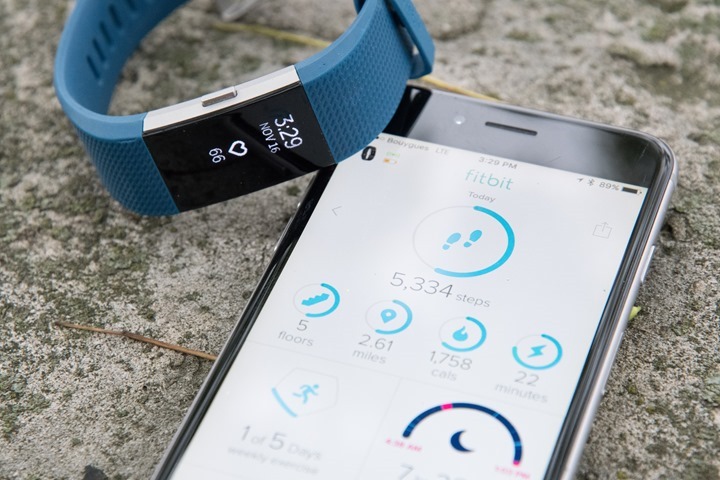
Over the last few months Fitbit has refreshed their mobile apps (or at least, their iOS app). Nothing major, but just cleaned up the look of things a bit. The mobile app is ultimately the epicenter of where you’ll check various Fitbit stats, be it your own stats, or friends that you’re taunting through your stepilicious activity.
The main page on the app covers all the stats for the day, and in the case of sleep – the previous night. It also covers any exercise you’ve completed with the tracker. You can tap on any given metric to see more detail about that piece. For example, tap the steps icon and you get details about the week in steps, and tap a given day and you’ll get a timeline of that day. Just like below.
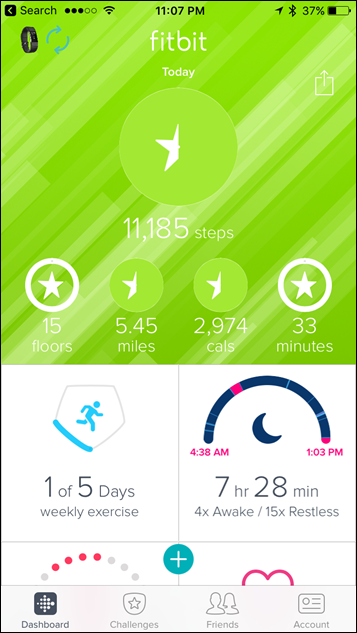

The same is true of sleep. As obvious, my sleep schedule has been all hosed up the last few days after returning from the US. The baby has decided to remain on some alternate time zone.
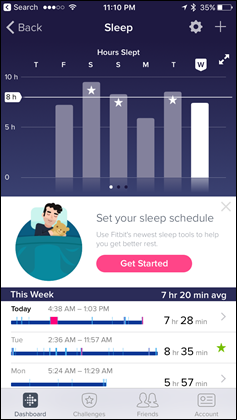
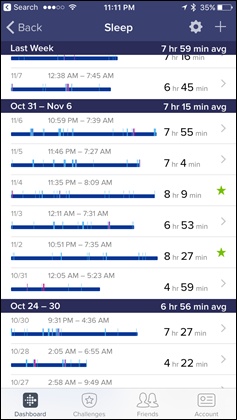
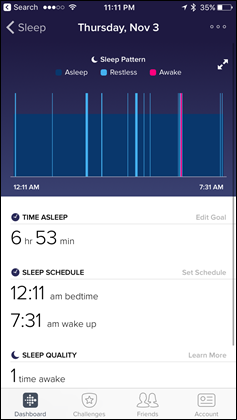
One of the big benefits of the Fitbit ecosystem is how many people use it. In my case I only have a whopping 4 friends, one of which is actually using their Fitbit still. Still, I can see how I rank up against her. I can also find other friends and check out my current friends’ badges.
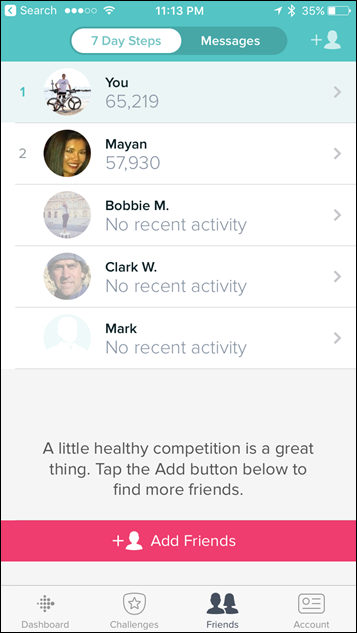
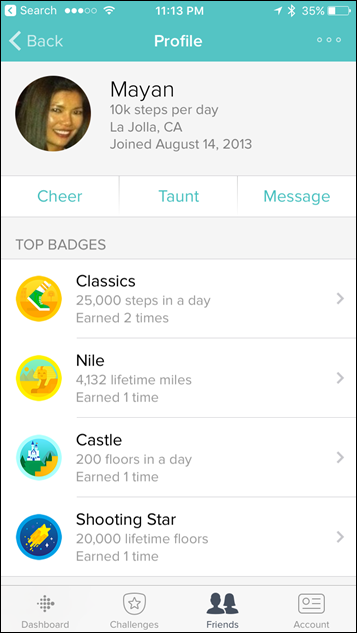
The app allows you to sign-up for challenges as well. These are designed to sucker you into walking more than you might otherwise.

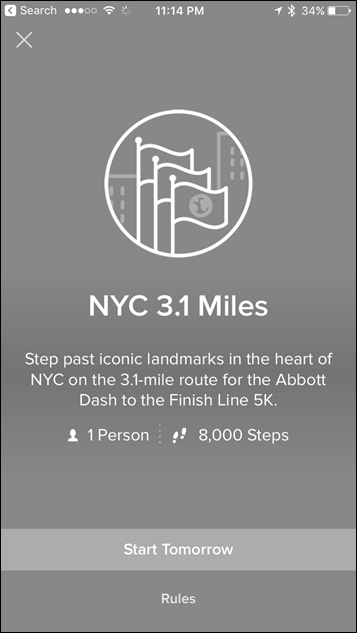
Beyond that, most of the remaining pages I’ve already showed within the post. These are primarily settings related, such as configuring the display on the unit and how it might greet you.
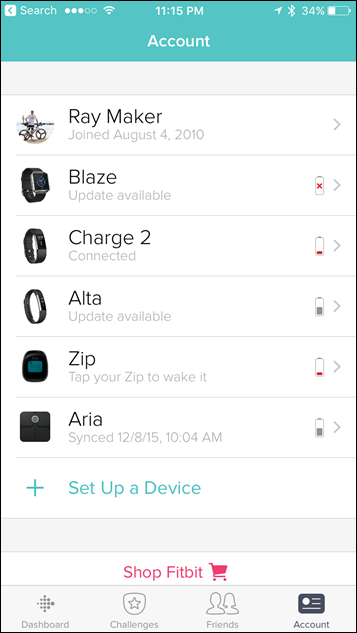

Additionally, a handful of other pages are within the app related to other devices or services. For example, a water bottle from Thermos that integrates with the Fitbit platform will show you how much you drank. And then of course the Fitbit WiFi scale as well.
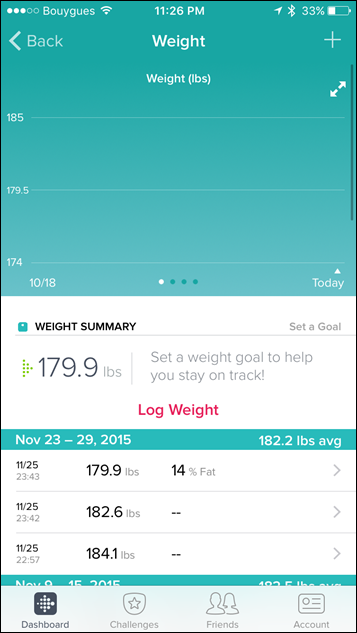

Ultimately the app works fairly well. It covers pretty much all the basics you might want. It doesn’t however go into much of the deeper analytic and insight pieces that some activity trackers are doing now, where they analyze your patterns and offer suggestions in areas such as sleep. But for the most part Fitbit is overall one of the leaders when it comes to their activity tracking smartphone app.
Product Comparisons:
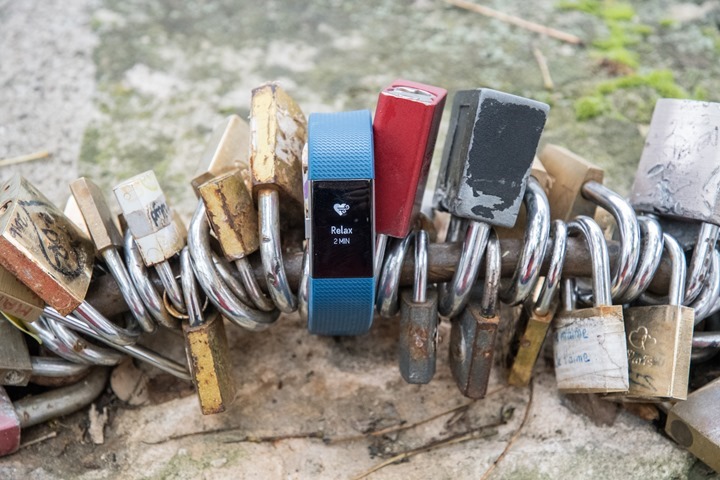
You’ll find the Fitbit Charge 2 within the product comparison tool for activity trackers. It’s not currently in the GPS-based product comparison portion, since it lacks a GPS chipset. If there’s interest, I can look at adding it into that database nonetheless. In any case, you can mix and match it against various activity trackers in the database. For the purposes of comparison below, I’ve compared it against the Garmin Vivosmart, Polar A360 and the original Fitbit Charge HR. But again, you can create your own comparison charts here.
And don’t forget, you can create your own comparison charts here within the product comparison tool.
Summary:
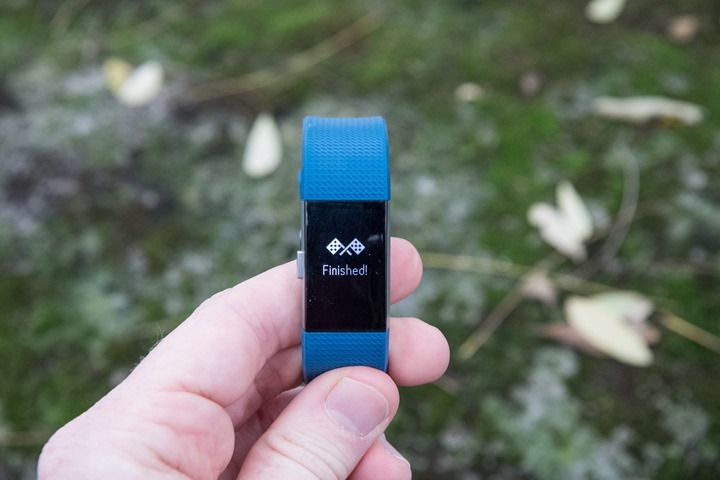
As with almost all Fitbit products, they tend to be a popular and well rounded offering. And the Charge 2 is mostly in that same vein. The unit includes new sport modes that help you to get better data about your specific activity. Plus, the separable bands are nice should you want to mix things up. And 24×7 HR accuracy continues to be generally good.
On the flip side, workout HR accuracy is highly mixed, especially in cycling. Further, new features like the breathing/relaxation pieces seem more like placebos, at least in terms of what the display is showing. Next, the Connected GPS functionality seems to be more troublesome than it’s been in the past, often not connecting properly and then dropping the connection without reason, along with missing miles. And lastly, the unit somehow still lacks proper waterproofing.
When companies get as big in market share as Fitbit, you start to see the slowdown in innovation, while competitors continue to push forward and innovate faster. We’ve seen that here with what are largely modest updates to the behemoth that is Fitbit. They got to that position for good reason of course – their platform is largely clean and easy to use, as are the wearables themselves. But when you look at the nearly 1-year old Vivosmart HR from Garmin, it’s more capable in virtually every way than the Fitbit Charge 2 (at the same price normally, though $30 cheaper right now on sale).
So my general advice on activity trackers is that if you find the features meet your requirements, select a device that matches your friends. If your friends/family are all on Fitbit, then it likely makes sense to match that – so you can benefit from the various social encouragement features. Inversely, if you already have a Garmin bike computer, then it makes sense to stay on Garmin so you get a single cohesive picture.
But if you don’t have any other techno-strings attached, you’re effectively a free agent and there’s plenty of great options out there. The world’s your oyster!
Wanna save 10%? Or found this review useful? Read on!
Hopefully you found this review useful. At the end of the day, I’m an athlete just like you looking for the most detail possible on a new purchase – so my review is written from the standpoint of how I used the device. The reviews generally take a lot of hours to put together, so it’s a fair bit of work (and labor of love). As you probably noticed by looking below, I also take time to answer all the questions posted in the comments – and there’s quite a bit of detail in there as well.
I’ve partnered with Clever Training to offer all DC Rainmaker readers an exclusive 10% discount across the board on all products (except clearance items). You can pickup the Fitbit Charge 2 (or any other Fitbit Charge 2 bands) from Clever Training. Then receive 10% off of everything in your cart by adding code DCR10BTF at checkout. By doing so, you not only support the site (and all the work I do here) – but you also get a sweet discount. And, since this item is more than $75, you get free US shipping as well.
Fitbit Charge 2 (select drop-down for size/colors)
Fitbit Aria Scale (compatible with Fitbit Charge 2, see my WiFi Scale roundup here)
Additionally, you can also use Amazon to purchase the unit (all colors shown after clicking through to the left) or accessories (though, no discount on Amazon). Or, anything else you pickup on Amazon helps support the site as well (socks, laundry detergent, cowbells). If you’re outside the US, I’ve got links to all of the major individual country Amazon stores on the sidebar towards the top. Though, Clever Training also ships there too and you get the 10% discount.
Thanks for reading!



























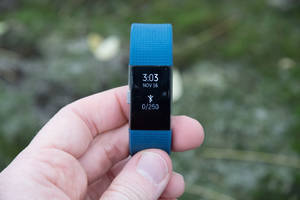
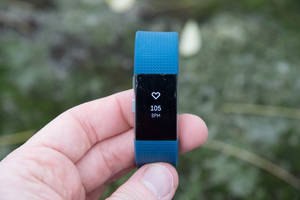












































































Thanks for the review Ray. How does the size of this unit compare to the Charge HR? I’ve heard conflicting stories- some say it feels bigger, others say it looks smaller. Is there a noticeable difference?
They use a different band type, so to me it feels smaller specifically because of that. I’ve gotta dig up my old Charge/Charge HR and add in some pics (couldn’t find them the other day). I’ll try and find those and do some better comparison pics.
Yes, its hard to see where innovation in this area is coming from nowadays. Which is why I use a Xiaomi Mi Band 2 for activity/alerts – it offers what I need (excellent battery ~ 25 days between charges, sleep alarams, customisable alerts and accurate step count) at a crazy good price (£20, which is basically $20 now anyways….).
Are you getting 8 days battery with HR and Bluetooth enabled?
My wife just got one a couple weeks ago and she haS to charge every other day when both of those features enabled the entire day.
A little concerned about such a big discrepency between hers and yours, thanks!
Yes, both enabled. If you’re only getting a day, then your unit be broke. :(
Hello Ray,
I’m surprised that you didn’t put some comparisons for the Total Calories burn for a day with this Fitbit HR 2 and some other similar competitor product.
My impression is that you would remark that there is a direct relation between the number of steps for the day and the Calories burn for the day, between this Fitbit HR 2 and other similar competitor.
I did this kind of comparison in the last 2 years between the:
Fitbit Charge HR (and Fitbit One),
Polar Loop (and Polar V800),
JawBone UP3,
and the Basis Peak,
and it was kind of surprising to see the difference of protocol used.
The Fitbit and the Polar were in the same boat (almost similar for a total of the day), but for the others (JawBone UP3 and Basis Peak), they were clearly in a different game.
My concern was to try to match the Calories Burn with the Calories eat (using MyFitnessPal), or at least to know the difference I should consider to try to match these.
Ray
What I would like to add:
I remarked that for the number of steps considered, a user had to walk in one direction for about 50 steps if he wanted to be sure that the count was correct, with the Basis Peak and the JawBone UP3.
So only walking say, 25 steps in one direction in an apartment and coming back each hours to move at least 50 steps per hour from the computer, was not considered by these product; I had to get out of the apartment each hour and walk 50 steps in one direction and come back to have these steps considered.
And these steps not considered had a direct impact on the total calories burn for the day.
I kind of remarked that there seems to be a relation of 10 for 1, between the number of steps and the calories burn.
So if there is a 4000 steps difference for the day between 2 competitor product, there was about 400 calories burn difference for the day. So for someone who want to match is Calorie IN with his Calories OUT, this difference is something to know.
Being a long time Polar user, I would have like to know what difference to expect with the Garmin products for example.
Thank You
Ray
One other point:
There was about a 25% difference for the Calories burn for the workouts, when I compare that with my V800 and the competitor I mentioned earlier (the V800 give me 25% more calories burn; after having checked with Polar, it seemed that it was because my resting heartrate was low for my age and they told me that their value was correct)
So, to be able to compare the total calories for the day, I used MyFitnessPal for the workouts to be considered with Fitbit, and I used Runtastic for JawBone.
With the Basis Peak there was no way to be able to use other datas source, so there was often 600-1000 calories burn difference for the day, between the Basis and it’s competitor. So the calories burn for the day was of no use with the Basis Peak.
Ray
Another point about the heartrate value during workouts:
I have a Fitbit HR and when I read about the lawsuit against Fitbit caused by the inaccuracy of the heartrate and the danger for certain users, I was really not surprised, considering what I remarked with my heartrate during workouts with the Fitbit HR.
I had bought this Fitbit HR mainly caused I wanted to have a Fitbit that I was sure that I wouldn’t loose on my arm (compared to the Fitbit One I had), and it was for the total calorie burn during the day, the silent alarm and the app quality, that I bought this product.
But for the workouts, I was trusting my V800 and when I saw the kind of heartrate graph that Fitbit was giving me for the workouts…, it was sure that I wouldn’t considered that.
So I was expecting that I would have the same inaccuracy if I would bought the new HR 2 with the heartrate during workouts.
I do often spinning workouts at lower intensity than running, and there, the accuracy problem is real visible.
I asked to Fitbit if I would have a better accuracy if I would buy another Fitbit HR, that maybe mine was a defect Fitbit HR, but they told me that it would be the same…
Ray
Good review. What are the better ways to get your heart rate up? :)
Question. I am a Jazzercise instructor and am interested in something like the fitbit charge 2. Though I would end up wearing it most of the time the thing I want it most for is to monitor my heart rate during class. Most classes start with a warm up then we increase our heart rate with each song, stay at the peak for about 12 minutes, then bring it back down. This cardio section lasts for about 40 minutes. Then we do strength routines for about 20 minutes. Class takes place indoors so weather is not an issue. But it is dance exercise so our arms move around a lot and do a variety of things, everything from punching, engaging them at our sides, swinging, pumping, etc. I tried on the Garmin Vivofit Smart as well as the fitbit charge 2 and found the fitbit charge 2 to be more comfortable. However, I was wondering if you had an opinion on which one you think would give a more accurate heart rate description for the kind of work out I do. Though it would be great to know exactly why my heart rate is during class, I know optical HR sensors are not fully accurate. I am more concerned about the device being able to accurately capture the changes in my heart rate.
Thank you for your time and for your reviews!
*why=what
Hi Ann-Marie:
I am a certified personal trainer and gym owner. I teach a wide variety of classes including TRX, GTS Gravity System, Cycling, and Kickboxing. Each one has unique demands on my fitness watch, and I have always owned several. I have a Fitbit Surge, which is OK until I do a kickboxing workout, and the heart rate results are all over the place. I had the Charge 2, and found it to be much worse. The watch randomly did not recognize my swipes, which became very annoying, especially when I needed a quick look at a particular screen. Also, the buckle on the band dug into my wrist to the point of leaving a mark and being really uncomfortable when I was wearing boxing gloves. The Surge did not have the same issue. I finally returned the Charge 2.
Through this whole process I also used a TomTom Spark 3. In the end, it was the most dependable and durable watch. Its performance was amazingly accurate during kickboxing, even when compared to the MyZone chest strap, which I consider to be the most accurate heart rate strap. It is waterproof (unlike the Charge 2 and Surge), and it has a wide range of workouts to choose from.
As an everyday watch, it is hard to beat. I will probably buy the Fenix 3 when the sale begins, but it would be more of a hiking, cross country watch, rather than a daily gym watch.
Hope this helps,
Mark
Hi Ray
Just a clarification, as I have recently started my Charge 2 review and saw that change I didn’t notice before.
The Fitbit app allows you to select WhatsApp as the source for messages, instead of SMS. At least in Android.
Still, no email or any other source.
Unfortunately iOS doesn’t have that option. :(
on the resting heart rate, i spent a long time exchanging emails with fitbit support trying to get them to clarify what their RHR values actually are and hence what they mean. i got all the generic and contradictory responses and eventually got something very vague but reading between the lines a bit it was clear that they use both sleep and awake readings and some sort of averaging or complex equation across the day to derive a value. they absolutely refused to give any indication of what that calculation might be. so it is not RHR by any conventional definition. typical fitbit doing it their way with little regard to informing or listening to their customers!
in my experience it is quite consistent and does track broad trends in my state – i’ve had a thyroid disorder the last 6 months so my RHR has been up and down all over the place. i have yet to clearly tell whether fitbit’s RHR is useful for tracking general health and training stress…
of note, my RHR values for the last 4 days just got revised upwards by 1BPM – all from 43 to 44. i can only assume that fitbit have tweaked their logic and backdated application of this a few days. of course this is moving further away from the real RHR (about 40 for me) and most of all what matters is consistency which is lost, hopefully in the name of progress…
On the waterproofing issue: I have a Charge HR and it does 7.5k a week in the pool over three sessions with no apparent ill effect (at least over the 6 months I’ve been doing it). Of course, there is no reason to wear it – merely I can’t be bothered to take it off (and if it breaks I get to upgrade to a 735xt!).
One other thing about the Charge HR – I really like the fact it has a proper watch band. A number of the competitor units have weird band closing systems which (at least to me aren’t secure or comfortable – and in the case of the Polar unit, positively ridiculous as the unit is constantly pushed out of its strap…)
My Charge HR died when I went swimming in a lake, the first time it had been exposed to water. Was wearing a long sleeve rash guard, so the watch wasn’t exposed to any direct splashes.
The HR uses a non-replaceable band, so if it is damaged or suffers from the dreaded bubble disease you’re left with a worthless brick once the 1 year warranty is over. Much prefer the HR2’s replaceable bands. I’d really prefer proper waterproofing so I could swim with it.
I went through 6 (six) Charge HR’s due to sweat/water intrusion. I never swam with any of them, they just died: stopped charging or very short battery life and had trouble syncing with my phone. Eventually they just refused to turn on or if they charged up, the battery life was a few minutes. I autopsied all of them and found an oily residue on the inside which seemed like my sweat perhaps mixed with oils. Fitbit replaced them under warranty until the last one. I noticed they had to replace so many under warranty that they made special packaging for warranty replacements. I run and bike a lot throughout the entire year. My Vivoactive HR is still ticking after 18+ months of the same level of activity but with some swimming and a Warrior Dash event as well, battery life is the same day in and day out: about 83% to 85% at the end of the night before I charge it up.
I am tempted to try the Charge 2, but hopefully it doesn’t die from my workout levels.
A bit off topic, but I’m a running & economics nerd (with way too much free time!) who has put together some analysis on Fitbit using Garmin’s Fitness division for comparison. If you are interested in chatting about the business side of fitness tech, I am happy to share. The report is free and there’s no need to register for anything as the site is purely for fun.
link to asymmetric.info
I might change the chart where it mentions the Charge HRs GPS capabilities. It also has GPS with phone sync whereas you just wrote “No”. It’s had it the whole time I’ve had my Charge HR (about a year)
Good call, will update.
Actually, are you sure?
I’ve still gotta find my older Charge units, but I can’t find a single reference to the Charge or Charge HR having Connected GPS as an option. Connected GPS means that you don’t need to interact with the app to get GPS, but rather, it triggers it from the wrist.
They do have ‘MobileRun’, which means that you start/stop the phone app and that in turn will take the HR readings from the watch (effectively making the watch a HR strap).
Is it not possible for you to review something without comparing it to a Garmin?
Why? So it makes someone feel better about buying something without doing research into competitive options? Whether those competitive options are better or worse is besies the point. If you want to read just the marketing pitch, then go to that companies website instead.
Garmin and Apple are among the biggest players in the game (and Apple isn’t comparable here). It would be laughable for me to pretend competitive options don’t exist, and that those options might actually even be better in certain cases.
Would be difficult to properly review anything without comparing it to similar things. As discerning consumers we (well I for one) like to know what products are out there and what their pros and cons are. Funny though about suggesting getting what your “friends” have. So my wife has a Fitbit activity tracker as do her friends and I have loads of Garmin GPS watches as do my running friends. What I have is no use to her and vice versa.
Ray,
Could you please add music control to your comparison chart? It’s one of the most important features of these devices for me.
Cheers!
Yup. I’ve got it on the regular GPS watch side, but not in the activity tracker database, easy enough to add in.
I’m an owner of the Fitbit Charge 2 and the inability to export Weight training workouts (.tcx with no gps data) plus the misconception of resting heart rate will lead me to resale the device. Come on Fitbit, make an effort!
Ray,
In this review for the charge 2 you mention some issues with RHR. You also mentioned some similar issues with the garmin vivosmart HR. If someone was looking for just steps, sleep, and resting HR tracking which would you recommend since they both sound like they have some issues with HR?
It’s nearly black friday and i’m looking for a first fitness tracker.
I thought im gonna buy fitbit charge2, but you said that the hrm doesnt work well during workout (hiit). So i have to consider again to buy it because I focus on accurate hrm. And i find that mio fuse does it well. But isnt it a old device? or are there any fitness tracker to buy nowaday?
I do jogging 2-3 days a week ( dont mind GPS because i bring my phone to listen music and track GPS)
I do hiit and weight training.
Dont focus on
– sleep tracking , notification from phone.
Focus on
– hr ( especially when i do hiit workout) , steps counting.
Which device would you recommend? Or mio fuse it okay for this then ?
For more information
I do not swim, cycling.
I do jogging , boxing , hiit , bodyweight and weight training.
Maybe I am just completely blind but, how did you get the GPS map on the Fitbit site??
I have looked at every setting I can find and I still have no idea how to do it.
Thanx
Try this link: link to fitbit.com
And then down below that you should be able to see them listed, just click on the various links to get the map.
QQ: Since my beloved Basis Peak is no more, I’m looking for a replacement that shows live running cadence–does the Charge 2, or Garmin vivosmart HR/HR+ do this?
I can’t find anything else on the tubes that specify.
Thanks for this timely review. My wife has been using a Garmin Vivosmart for almost 2 years and I’m looking to get her a new one with the HR built in because she doesn’t want to wear a strap to jog or do a gym workout.
A co-worker passed by as I started reading this review and showed me how much he is liking his Charge 2. I was getting excited about the multiple sports modes, but as Ray points out not being waterproof is a roadblock. She does aquatic therapy (working with people in the pool) and that is a requirement.
So back to my original Garmin Vivosmart HR plan. Though I will probably check out the Tom Tom Spark 3 mentioned in the comments.
Thanks for the great information!
I was one of the (un)fortunate? ones who pre-ordered the Charge 2 on Amazon for $99. I have been wearing it on my dominant right hand while wearing my FR235 on my left hand. The Charge 2 is almost always 300-500 steps higher than the FR235. I will switch hands to see if it makes a difference. The odd thing is that if I go out running, then both the step counts end up being within 10 of one another immediately after the run. They soon start to diverge after that however.
Like Ray has mentioned, the Active GPS is indeed wonky. I thought it was my phone, until I read this post. It would track really well through the phone, then just completely drop it. This happened multiple times while biking as well as running. I eventually gave up using the AGPS. The distance based off of cadence is also always .5 mile less than my FR235.
The HR monitoring of the Charge 2 is not accurate at all. Biking is a complete miss. With Jogging, its always 15-20bpm less than the FR235 paired with the Scosche. (FR avg 162, max 181 vs CH2 avg 141, max 151) I have ran without the Scosche and that is usually the same result as well.
Also, I have really tiny wrists, and like to wear my watches a little bit loose (Fitbit even recommends that). When I rest my wrists to type, the entire watch is pushed up, away from my arm. The same things does not happen to the FR. That is due to the FR having actual hinges, wearas the CH2 the band is solid.
I have gotten the VO2 max to work, but I trust the FR more.
Some things I like about the CH2. The app is much easier to use than Garmin.
The sleep tracking appears to be way better. The FR often doesnt get the start time right. The CH2 somehow is able to distinguish between when Im actually asleep and when Im just lying there browsing my phone before I sleep.
Have not bought fitbit but have been following the products for a couple of years. Looks like the Charge 2 might meet my needs. I don’t run but do exercise on the treadmill and indoor exercise bike. Does the product work with indoor exercise bikes?
Also, I have an iPhone 5S. Do you think there is a big difference between GPS performance between the iPhone 5’s and the iPhone 6’s?
Thanks for making it so simple that a technologically challenged person can understand!
Wow, I’m surprised to see the steps accuracy be so different across other products. I started with a fitbit flex then upgraded to a ChargeHR. I came undone when I bought the Blaze and it was consistently under reporting. Within 2 months I bought the Charge 2 and have an 11km walk into work each day. The Charge 2 would report just over 10,000 steps which would mean that I have almost a 1.1 meter stride. On checking by walking 100 steps and counting, it was always reporting 20 – 30% less. When all you want out of a fitbit is for it to accurately track steps and it gets it so wrong then the product is a failure. Reading forums they state work arounds like not walking too fast and not swinging your arm.
To be honest I don’t see a contradiction in the explanation on how resting heart rate is calculated: they say they take waking and sleeping heart rate data and put them together to *estimate* (in some unkwnown way) what they consider to be resting heart rate, which is not necessarily the lowest seen during the day
Thanks for the great review again! I’ve just received the charge 2 for my birthday and will now try to find the best way to consolidate its data with the data gathered from my garmin swim for my swim trainings. If anyone has suggestions about How to best go about this it would be much appreciated.
Hi, great review!
You said Fitbit is investigating the inaccurate distances recorded for bike rides. Is there any update on this please? I have had the same issue and it’s clearly not the fault of my phone as Strava/Google maps are both accurate.
First of all, thanks for the review, very easy to follow and read..much appreciated.
I have the Fit Bit charge and often have problems with the date/time setting not being accurate especially once the battery needs a full recharge.
How does the Fit Bit charge 2 compare-Is that problem then resolved?
Thanks,
Sonia
Hi Ray
Very useful article, thank you, especially having just moved from the HR to the charge 2.I cycled 42 km this morning, iphone only recorded 32 km (as you saying) and this translated into about 8500 steps. On my previous Fitbit this would have been way more steps – how does this calculation work? 10000 steps is the parameter required by my gym contract to earn points so the discrepancy is really annoying especially when you have just completed 21/2 hours of exercise and still need to walk to get to 10000 steps!
Hi,
I was wondering if you might be able to recommend a band based on my usage
1. Primarily interested in getting an estimate of calories burned over 24 hours
2. Only activity I participate in is a daily 5km run, which takes me about 35 mins. It’d be great to get accurate enough read of my heart rate to make sure I am maximising the weight loss
3. Good sleep tracker and resting heart rate measure is a plus
4. Calorie count during run is more important than distance because I use strava on my phone for that. Since I stream music, it doesn’t make sense to leave the phone at home.
Great in-depth review. I want to clarify something, though – you said it cannot export HR data unless the activity used GPS. So – does that mean HR data for a workout you tagged as Yoga, for example, is not visible in the app?
Nicole,
I think the reviewer is referring to exporting data from the FitBit website, not from the tracker to the app.
Yes you can export HR data from a yoga workout to the app viaa Bluetooth sync.
For those wondering about Fitbit integrating into iOS HealthKit, it doesn’t exist and appears unlikely to happen.
When there is a feature request, Fitbit moderators on the community forum instruct users to either a) submit a feature suggestion on that forum, or b) vote on an existing feature suggestion.
The “Integrate with iOS Health” suggestion was submitted June 2, 2014 (almost 3 years ago) and is marked Under Consideration. It has been the top voted suggestion, with 4961 votes as I write this comment. There is a feature in that forum to show the “Top” voted suggestions. Right now the 2nd place suggestion has 3134 votes, so iOS Health integration has almost 60% more votes.
Sometime in January/February 2017, Fitbit decided to hide the iOS Health suggestions from the Top list. When asked why, a Fitbit employee replied on Feb 6, 2017 that “I just wanted to reach out and let everyone know that we are taking some steps to better the user experience on our Community. We’re looking at different ways to maximize the power of the Community we have. This feature suggestion can still be viewed by using the Community search tool and as some users mentioned, Google.” Page 174 link to community.fitbit.com
Why would Fitbit hide the #1 voted suggestion to improve the experience? Is hiding customer feedback really “taking some steps to better the user experience on our Community” and “different ways to maximize the power of the Community?” I’m frustrated that my Fitbit Aria scale doesn’t sync to HealthKit. Fitbit has no problem taking advantage of other iOS features, why won’t they integrate my data into HealthKit? Why can’t I import GPS and HR data?
It won’t happen.
Fitbit has been excruciatingly clear about that since Day 1. It’s essentially a giant pissing match between Fitbit and Apple…and oddly enough, Fitbit actually seems to be winning this one (despite the collateral damage to some consumers).
Ray, I wouldn’t say Fitbit is “winning” – # devices sold is down 39% year-to-year for the first quarter, revenue down, gross margin down, etc. Although Apple doesn’t provide concrete numbers, its pretty clear they “won” device sales last quarter.
Having a Feature Suggestion forum, and hiding the #1 voted “Integrate with iOS Health” hasn’t worked for them either – its picked up another ~1000 votes for it. And what does hiding that suggestion say about Fitbit management?
Ok I get it, Fitbit pulled support for Microsoft HealthVault last year, and doesn’t integrate with Google Health or Apple HealthKit. That doesn’t stop 3rd parties from creating apps to do it, I use MyFitnessPal to get scale data into HealthKit, and there are other apps. Or use the Fitbit-to-Strava sync and then Strava puts my ride into HealthKit. So if I can still auto-sync my data into HealthKit via 3rd parties, how is that winning?
Clearly Fitbit is a different company from the one that issued a recall on my Force. The new Fitbit isn’t so helpful, or very good at software/firmware. Go spend 15 minutes looking at the forums, angry Surge customers dealing with a defective band design are now out of warranty and being offered 25% discounts on a future purchase. Meanwhile Fitbit quarterly reports show increasing warranty reserves (big surprise) for legacy products like Surge and Charge. The Surge firmware hasn’t been updated for 19 months (Sept 2015), still being sold and still the most expensive Fitbit. Blaze has been out for a year and it still uses “steps x stride” to calculate walking distance instead of using GPS (yes, Connected GPS is only used to draw map when recording a Walk). And for running and cycling users continue to report Connected GPS issues – inaccurate distance both under and over reporting. I gave up caring, and am ready to sell my Blaze.
I had a good run with Fitbit – Flex, Force, Surge, and Blaze – but there isn’t a single fitness metric that I care about that lives in the Fitbit world, despite the Surge/Blaze/Charge2 having multi-sport tracking. Its sad really, Fitbit has a nice, good looking app, but no real depth. I’d love to see a mashup between Fitbit app and Garmin devices!
Fitbit outsold Apple in Q4 2016 (using IDC, which isn’t perfect, but generally works), 6.5M to 4.4M units. Seems they won.
Fitbit had a down Q1 2017 comparative to 2016 data, because Fitbit released three new wearables in that time period last year. They released one this year.
The problem with going to forums and looking at quality issues is like anything else: Only upset people go there. With 6.5 MILLION units in purely Q4 alone this year, there’s going to be some upset people. Go check out Apple’s forums and you’ll find the same.
Which isn’t to say Fitbit shouldn’t integrate with Apple Health – perhaps they should. But to say that that Apple’s winning isn’t true. By every metric one can use, Fitbit is winning this battle.
Interesting, I do see the Q1 numbers now (catching up on Engadget for the day). I would echo again that the lack of new products in Q1 for Fitbit, fueled my lots of folks talking about their upcoming smartwatch (err…newer smartwatch).
If you want to collaborate the quality story, just read a couple of earnings call transcripts on SeekingAlpha (free registration required). On at least two occasions this past year management has reported a large increase in warranty reserves for an expected increase in warranty returns with “legacy” products – Charge, Charge HR, and Surge were called out by name by mgmt on Q4 call. Its also interesting to go look at the 1 and 2 star reviews on Amazon for those devices, the Charge has over 14,000 reviews and ~30% are 1/2 stars with the most common complaint being bands falling apart. Last year Fitbit ended the entire year with only 4% increase in devices sold, and a net loss. And Q4, the holiday quarter, saw 20% drop in devices sales over the previous year. From the Q1 earnings call last week, mgmt commented that latest drop in sales was driven by Fitbit shipping too much product in late 2016, and that unsold inventory needs to leave retailers warehouses and stores before things get better. To recap, our winner is losing losing money, pushed less inventory out the door (vs 2015) during the big 2016 holiday quarter, and there was still too much inventory in Q1 2017 so sales dropped even more. For obvious reasons I’m still sitting on the sidelines as a potential investor in the stock, love the app although it needs more fitness metrics, but the business fundamentals haven’t been solid since the blowout Q4 2015.
The good news? My Blaze doesn’t suffer from band issues, it may not have the best build quality and lacks swimmable waterproofing but its not falling apart like my Surge. Hoping the upcoming smartwatch is compelling vs Apple Watch.
Apple is playing a different game, they left a lot of room for 3rd parties to develop best-in-class apps although Apple should be embarrassed that GPS/cadence/power are not in HealthKit. Its funny you mention walled garden in the Apple Watch review, because I’ve felt that way about Fitbit since the Surge was launched – can’t import HR, can’t import GPS, can’t export TCX unless it has GPS data. And still true now that Fitbit is on 3rd generation of multi-sport trackers.
Neither Fitbit or Apple Watch provide metrics to track increasing/decreasing fitness levels. Only my Watch plays nice with phone/web apps that I use for that purpose. Oddly out of Garmin/Fitbit/Apple only my Watch supports weight lifting via the Strong app. Really wish Garmin would properly support weight lifting.
Thanks for the discussion, looking forward to seeing how the rest of 2017 unfolds in the wearables space and of course your excellent reviews!
Nice posting. Last November on my hobby blog, I did an analysis of FitBit’s operational performance vs. Garmin. Maybe you’ll find it interesting. link to asymmetric.info
What kind of information for elliptical can Charge 2 collect and provide (e.g. distance)?
I am retiring my broke Surge and do not want another one – I am thinking between the charge 2 and the Garmin Vivosmart HR+. I would just get the Garmin but I hate the activity side of their web site. I think the heart rate graph and the sleep section are terrible compared to Fitbit’s. But I do like the built in GPS (I never run with my phone.)
My solution for daily running is to base my distance as best I can on steps. Can I easily change the stride length of the charge 2 either in the app or on the web site. I would go for a 5 mile run with my phone and then fool around with stride length to attempt a (close) match.
Does this sound feasible? Can the data from the GArmin go to a different web site that shows heart rate and sleep better?
TIA.
Fitbit Charge 2 or Garmin Vivosport??
My wife uses a Fitbit Charge2 and I picked up a Wahoo Kicker Snap trainer for us to share. Are there any aps which she could use that picks up the HR from her fitbit and uses the power from the trainer, and maybe even allows us to add in a bluetooth cadence sensor too? She doesn’t like chest straps, hence my question about using her Charge2 as a HR sending device.
If the Charge2 is a no-go, what inexpensive arm mounted HR monitor would you suggest? I’m saying inexpensive as this is just for indoor riding.
Ideally I wish there was Strava integration but I hear that’s a no-go. How about Zwift and the charge2? Will that work?
BTW, you are a huge resource on so many topics…I’m continually impressed. Thank you for what you do.
Hi Ray
I just wanted to point out that you mentioned in the beginning of your review that the Charge 2 can only receive text message notifications but this is incorrect. On the app you can switch to Facebook messenger or Whatsapp notifications. I have mine set to FB Messenger and it works perfectly, displaying sender and message. The only issue I have with notifications is the range from which they come through. For example in work, I have to leave my phone in the staff room and I don’t receive notifications on the shop floor. :/
Last I checked that’s actually only for Android, not iOS.
If I am pushing a stroller while running/walking will the Fitbit Charge 2 still track my steps? I’ve heard that if your arm isn’t “swinging” that the step tracker doesn’t work.
Not well (I often push a stroller). Depending on your body and how much bounce there is within the step, you might get some tracking.
One tip that I and my wife do is to simply stick the activity tracker in our pocket (or her in her sports bra), which usually does the trick to count steps. Or, if comfortable, pushing with one hand.
Thanks! I’m assuming this is the same for all activity trackers, correct? Have you found a brand that tracks well when pushing a stroller?
Correct, basically the same for all trackers.
Sometimes you see slight nuances between models/brand and strollers/carts – but for the most part they’re all pretty similar here.